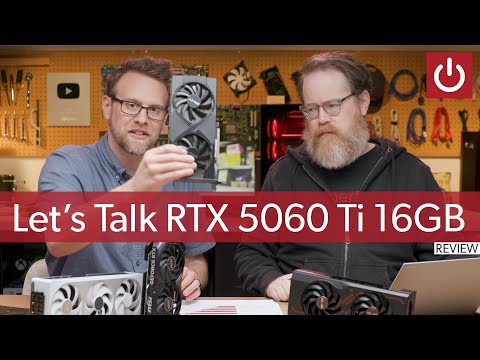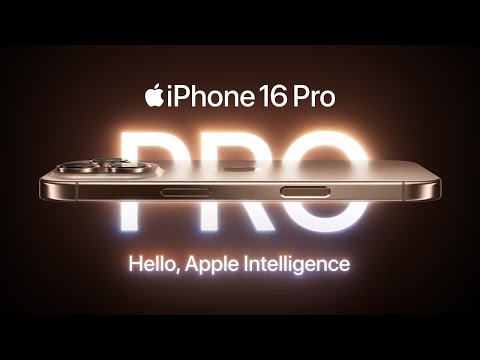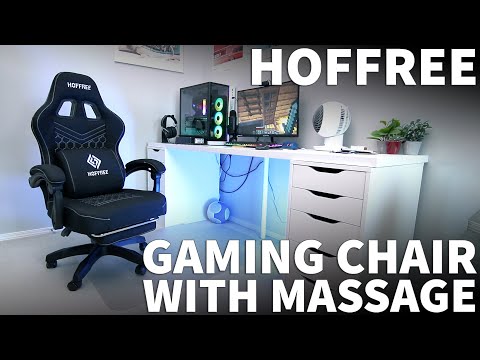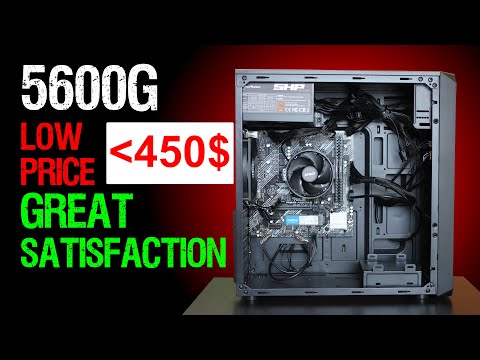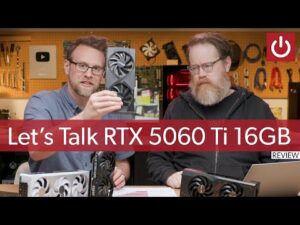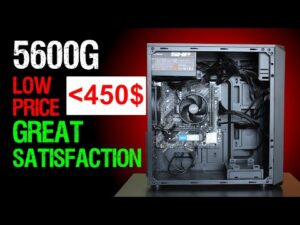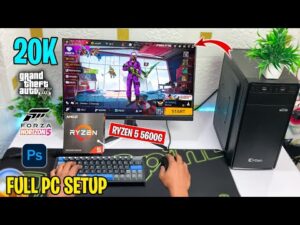RTX 5060 Ti 16GB: 1080p Testing & Pricing Pondering
Adam I am super stoked man. That was allot of energy. Adam, I am moderately stoked man. For why? Because it’s video card day. Oh, again. Again? Yeah, again. We got another GPU. This one, this time in front of us
is the RTX 5060 TI 16 gigabyte version. Yeah, the Tis for titanium in
the 16GB is for 16GB. Yes, we have done the testing with this
new GPU that had just been released. It is available as of today,
along with the eight gigabyte version of the 5060 TI spoilers. We do not have that one on hand. It’s weird they didn’t send a bunch
of the aging cards out, it seems like. Yeah, so we don’t know. We’re just here to talk about the 16
gigabyte version and then later,
theoretically the 5060 version. So we will try to get the, the,
our hands on these other cards. But let’s go over this. Today we’re going to talk about, taking it through the test
suite and creative application. We’ve got, you know, gaming, tracing,
registering rasterization. We got some power testing. We’re going to talk about price. But you know, what’s. The tldr, though? Let’s put the straight up front. Yeah. The Tldr is,
it is theoretically dropped price over the mSRP of the 4060
to 60 gigabyte version. Okay, theoretically,
we’ll talk about price later. In theory. In theory, and the performance uplift. I mean, we’re seeing anywhere from from 8%
to like 32% performance uplift. So performance is good at a
theoretical cheaper price. And, zero change in power draw. So okay. But it, it brings all the deals for stuff
that’s from the higher end cards into this lower end price. Exactly. So yeah from, from the top level,
the 16 gigabyte version specifically seems to be
seems to be not too bad. You know,
if you can get it at the right price. So the model we have specifically,
was sent to us by Nvidia. This is the penny GeForce RTX 5060
TI 16 gigabyte version on the box. It says stealth mode. That’s not necessarily
the the actual model name. But that’s
the one that we have, in today. And that means no lights,
no nothing, no fancy RGB nothing. Yeah. Stealth mode seems to to mean that it’s,
you know, just real cool. Quiet, no lights. Just a simple design.
I do like it. It is. Yeah. A matte finish
just under, a two slot card. Like, I like that. It’s simple, but not too simple. Like,
it does have a design language to it. And it has a nice big cooler
that has the flow through design on the back. So it was relatively quiet. The thing that’s noteworthy to me
about the cards in this price range, even from Nvidia,
is that they still use the old eight pen PCI express power connector,
which makes sense. Controversial 12 volt high power. Yeah. Well, I mean, it makes sense
that that this, power draw. So, you know, the
the only thing I will note is that the eight pin PCIe
power was really close to the slot cover. I’ve never seen it
that close to the slot cover. Do you think would have trouble
reaching a case? I know you test open air. I yeah, I mean, maybe
I guess it depends on how big your case is and how long your, your cable is,
but it’s something to at least consider if you’re looking at this, Version
specifically. So what do you compare it to? So I compared it specifically to a 4060
TI 16 gigabyte version. Okay. To keep that, you know,
generational increase of the size, I have a step up 5070, to compare it
there to see what the next step up is. And then on the AMD side,
I went with a 7700 XT, mainly because that was a good match
for the 4060 TI, 16 gigabyte version. In terms. Of price. Or performance in both. Yeah. You kind of traded blows
and it came a little lower for price. This actually does now. And the XRP
come in a little bit of a higher price, compared to the new 5060
TI 16 gigabyte version. So yeah,
I guess we will see how that performs. So item what was your test
bench look like for this subject. Ground up. So it’s the same exact bench
I’ve been using, since about December. Say no more. Yeah. If you want to go look at the details,
look down in the description. But at the heart of it is a Ryzen nine,
79, 79, 50 x 3D part one. So one of the best CPUs
that you can get out there. And then I ran through all these on
the open air test bench, you know, kind of kind of doing my testing. So,
same kind of stuff. If you want to go look at the details,
look down in the description. But let’s start off
with, I, specifically Procyon. I text generation,
the uplift we’re seeing here, it’s about 20% in 53.5,
about 30% in Lama 3.1. That’s that’s. This is from pretty good 4060 to 5060. TI. Exactly. Yeah. And and the interesting thing here is AMD cards kind of suffer here
because of lack of tensor cores I assume. So what about video editing? Something near and dear to my heart. Yeah. This is Premiere
Pro, as tested with, puja bench. And we’re seeing an increase
from the 4060 TI to the 5060
TI of 18%, which is pretty very healthy. And it went from kind of being neck
and neck with that 7700 XT, to definitely being,
you know, a nice big leap over that. But you’re here for games. You’re probably I love games. So we’re going to get into the gaming
benchmarks. Now, that was just kind of a
quick warm up. Yeah.
And I tested, three different ways. I do have some test benches in here
that are looking just at rasterization, some that are looking at just ray tracing
and then some that are looking at ray tracing and upscaling. So, you know,
we’re going to kind of go through that. I will say all this was tested at 1080p
because for the most part I would call this a 1080p card. There probably others who are going
to have, you know, 1440 testing. But, you know, like, I think that’s a that’s a nice to have at this level,
not a necessity. So I with the limited time I have,
I just focused on AP. So first up is, Call of Duty
Black Ops six. So this is 1080p with the extreme preset. No, no frame gen,
but it does have upscale a two times, meaning it’s actually rendering,
at five £0.40, and we’re only seeing an uplift of about 8%,
which was kind of, you know, not great. Call it underwhelming. What are the one sensor but the same two? About the same. Yeah. So, let’s move over to another
game, then. This is Assassin’s Creed Valhalla. This is actually at, pure 1080p,
no upscaling, ultra high preset. So the highest preset they have,
and we’re actually seeing a 14% jump here, and it finally falls in line
with the 7700 XT that we, that we see on on this, this
benchmark chart. So, you know, okay, so catching up. This looks like memory memory
bus increase, right. Yeah. Maybe I don’t know. And then for next up
we have shadow the Tomb Raider at 1080p. Highest preset,
but no raytracing, no upscaling. So these are our farm to table pixels,
that we’re getting here. And, it was actually a 22% increase. Pretty good jump from the 4060
TI to the 5060 TI. You know, for for benchmarks
that don’t feature frame generation, this is maybe the best uplift
we’ve seen generation to generation on any of these phones in the past. Yeah, maybe. Well, we’ve got one more
that doesn’t feature ray tracing. This is Tom Clancy’s
Rainbow Six Siege 1080p with the very high preset,
but at 100% scale. Because if you don’t know, if you go in and set one of the presets, it actually defaults
to a 50% render scale. So I brought it all the way up to 100%,
meaning this is true 1080p. And here we are seeing a 32% increase getting all the way up to, you know,
just shy of 300 frames per second. That’s a lot of frames per second. You know, I think I could win games
with that many frames. Yeah. I to, to, to be honest, I did not expect
to see those bigger jumps in pure raster. Like, I mean, it depended on the game,
you know, like some of it was only about 8%,
but all the way up to 32%. It’s interesting
because when you get to a certain point, then the bottlenecks start to shift
around a little bit sometimes in games. And it varies on a game by game basis, so. Could be the bus width
being only under 128. You know, it
could be the actual rendering performance. Either way, none of those games exhibited
like running into Vram limitations. I mean, 16GB is
is is plenty plenty at this level. So now let’s look at kind of ray tracing,
a little bit on the lighter side. So first up is F1 2024. This is 1080p,
with the ultra high preset, which does have a little bit of light ray tracing,
but there’s no upscaling, no frame gen. We’re seeing a 16% uplift. That’s not that’s.
Not too. Bad. Yeah, yeah. And once again finally catching up
a little exceeding the 7700 XT. Okay. Which surprisingly did that. Well, even with ray tracing involved,
typically the car doesn’t I mean, doesn’t hold up as. Much just to be the ray tracing in F1
2024 is is really light. It’s basically shiny surfaces on the cars. Exactly. Yeah. The next one is also kind of a
more console level implementation of ray tracing. This is Returnal. This is a pure
ten ATP with the epic preset. Art is on, but it once again
is very light implementation. And we see about 90%. So these. Are all. Respectable numbers. Same thing we’re getting here. Which I will say
Returnal can stress the GPU very hard core, especially on the Vram. So, like, I would be curious to see
how the eight does, in a test like this. Maybe we’ll get to that later. Next up, let’s get into a little bit
more heavily of ray tracing. This one, we all know favors Nvidia. Anyway, this is Black Mist Wukong. So I am not surprised by the
the poor performance of the AMD card. But, you know, the the generally
the generational uplift is about 22%. So once again, in line with kind of
the other uplift that we’re seeing. And you’re hitting the the thing to note
here is you’re hitting numbers that are actually fast enough
that you can turn on the frame gen and see appreciable benefit. I don’t think Wukong actually does
frame gen. It does, but I did not have it on right. But I did have upscaling on here. But the fact that you’re running
at 60 frames per second, I mean, it’s it means it’s an option. You can get that to 124
when you flip on. Exactly. Yeah. Yeah, yeah. So next
up, is kind of a suite of, of cyberpunk. I love the cyberpunk put it, because cyberpunk is a really good way
to test, GPU performance. Mainly because it is like one of the best games out there that can kind of push
all the bells and whistles. But I actually ran it in
multiple different ways because it is kind of interesting
to see how it. Performs
in different in raster ray tracing. And then all the dLSS stuff turned off. Yeah. So the first one is, pure raster. So this is the ultra preset 1080p, no
upscaling, no arty, no frame gen. This is just pure raster. And we’re seeing a 32%
jump generationally, which, I, I had to double check my numbers
because this, this seems, like a very large jump,
but man, that is really nice. And once again, finally matches and
exceeds just a little bit that 7700 XT. So yeah, I’m happy with this. Yeah, it’s
I mean, that’s a remarkable uplift. Yeah.
But now let’s turn on, path tracing. So this is, the, 1080p
with the overdrive preset. So this is full path tracing,
which is going to be very,
very intense on a card at this caliber. But I did
rely on a little bit of upscale. So this is, using upscaled 1.7 times. So that’s like whatever
the equivalent mode. So, yeah. So deals has quality, FSR quality,
but no frame gen. And here we’re not seeing
as big of an uplift about 14%. But this does get us, you know like just under that
that magic 60 frames per second. For full path tracing a ten ADP with,
you know, just a slight bit of upscaling. This this is nice. I mean. Again, it’s fast enough
that you can flip on frame Jim. Yeah. Well let’s do that. So flipping on frame gen,
I have two, things here. All of these are listed out at free
Gen times two, except for that, that other one
that has mfg times one more. That is way bigger.
Yeah, that. Is way bigger. So with just times two,
we’re talking about 101 frames per second. And because we’re using a base of 60
of just under 60, like, you know,
it should theoretically feel, fine. And that is also a 14%
increase over the previous generation. And then, of course,
if you want to turn it on all the way to times
for Multi-Frame gen, you sitting around 184,
frames per second. So, yeah, like good performance. All around that that’s that’s the,
you know, the testing suite. Passive. Yeah. I wish I had more time. I wish I had my hands on an eight
gig version, you know, to kind of see where the capacity kind of falls,
you know, on that. But for the most part, I mean, what I was
seeing was like, okay, for 1080p, if you’re a 1080p gamer and, you know,
you play a mix of old games and new games like the 16 gigabyte version
seems to to be very adequate. So the performance seems pretty good. How’s the power consumption? Yeah. So, power is interesting because that is
usually the last thing I test. So, I looked at the numbers,
and I assumed that with its increase in performance, it’s not free. They’re probably, you know, having to add a little bit
more power to the actual board. But under my gaming workload,
I here, we are seeing it is turning in about the same peak, you know,
compared to the previous generation. So, but, you know,
just shy of 300W on both of these 4060 or the 60 TI class cards,
which is really nice. And, way under the 7700 XT 60, which we knew was not going to be the
the most efficient card out there anyway. But yeah. So you’re getting that kind of performance
at essentially the same power draw. And so yeah, like and at a theoretically
cheaper price, that’s not bad. And to be clear,
these are a full system power, tracking. Not just that we didn’t just
we don’t just isolate the boards. Yeah, it’s too challenging. This is this is. A full system. Yeah. So, like, I mean, in the idle, it’s
actually a little bit lower on idle than than the other GPU, so. Okay. Yeah. So I mean, all in. All, once I sat down and looked at the numbers,
I was like, okay, this is not bad. Then you factor in the mSRP,
you know, being being $70 lower
than the previous generation. I was pleasantly surprised. But what’s
what are the cards going to really cost? Yeah. So that’s the hard part, right. Because you know, we’re testing
we have the actual, information that we have in hand. We have the pricing that Nvidia
and the port partners have have said that they would like to hit, but,
I mean, we’re recording this the day before, so we actually have no idea
what street pricing is going to be like. And on top of that, with all the the stuff
that’s going on in the world with tariffs and things like that, it’s
really messing with prices. So if I were to sit here
and try to give any sort of value judgment or, you know, how, you know, like, like,
oh, maybe, maybe get this instead. It’s it’s hard. Well, so no idea. What’s the breakdown on pricing
for these cards in general? The 5060 is $300, $300. The 5060 to 8 gig, is 380. Yeah. And then the 5060 TI 16 gig is 430. So $50 premium from 8 to 16. Which, I don’t know, we haven’t tested it, but by all accounts,
it’s probably worth the $50 increase we will have to see once we do,
you know, the testing. And then for you to drop all the way
down to that 5060, I really don’t know. Like,
we definitely have to test for that one. But once again, that’s that’s
all based off of theoretical pricing. We have no idea. And these cards all have the all the same like video encode features and stuff
like that of the other five six card. So it’s AB one correct code, all that. Yeah,
I know that a good card does not seem like they just don’t seem viable for games
right now. I mean, it’s hard because
it really depends on what you do, right? If you were just playing Fortnite,
you know, and 1080p at 60 frames per second and you don’t really care, you can probably get away
with a good situation. Switch. Exactly. You know, like like, you know,
if you’re playing, some e-sports, other e-sports style, I don’t know, like,
you can have a good experience with an naked card. Sure. I mean, we’ll have to see, you know, when we get the card, user
testing and stuff like that. But I think where it falls down
is more like, okay, if you’re somebody who heavily plays brand new games, games
that are trying to bleed, you know, push the bleeding edge
like Indiana Jones or something like that, then yeah,
you’re going to run into problems. And not only that, you’re
just going to run into worse and worse problems in the future. Well, I was just say one of the things we learned testing the
the 16 gig cards at 4K is that, the games that react poorly
to running it, to filling up all of your Vram,
which in fairness, you can only do with
a couple of games right now. The results are bad. Like the before,
it has an enormous impact on performance. So and and we learned that you’re
not going to be able to use dLSS or upscaling your frame gen. Those consume Ram as well and you don’t. There’s no net Ram savings
for using upscaling or whatever, you know, to render at a lower resolution. I mean, and it’s one of those things that it’s it’s
something you have to plan for because you don’t actually know
where the bottlenecks are going to be,
especially down at this range. The bottleneck could be pure performance. You know, the
the actual Cuda cores in there. The bottleneck could be the 128 bit memory bus, you know,
like so it’s not just the capacity. It could also be the thinner memory bus
that you’re running into. So like I think most people generally, you know, like to to
I don’t want to say this term but future proof themselves
or try to try to, you know, mitigate risk. If whatever games that you’re playing
then yeah, you probably want to try to shell out a little bit more,
more money for more Vram. But, you know, like I can
I can also see that the wide majority of gamers out there
that buy at this price range, that don’t care about performance
and just, you know, just play a game and have no idea what a frame rate
counter is, you know, like, yeah. So I don’t know if if you don’t
if you don’t like the eight gig version, then don’t buy it. But wow. But while the 16 gig version actually,
you know, like, I’m not seeing too many things that seem to be holding it back right now
in the test suite that we have for. 20, feels like a 430.
Seems like a reasonable also. So I mean, I guess that’s
the other question is how are they talking about prices? Ask around
because it’s like we’ve been through the whole gamut of launching before
we knew that they were going to be tariffs launching after the tariffs had already
been hit and hadn’t been changed too much. And now we’re into a post, post tariff
announce post tariff cut,
post tariff delay, post tariff. Like what’s going to happen
three hours from now? I don’t know how is Nvidia and how are the
AIB partners communicating about this. So I only heard from Nvidia
and it was pretty much just like. We are now. Okay. Right. I mean, they set a price that they said
the ABS need to set their own pricing, and then it’s
going to fluctuate from there. So I have no idea. Like we’re in a weird wild West
with this stuff. And so, you know, yeah, to at least sometime in the future number of months
if you want to, you know, if you’re watching this later, hopefully
this the at least the performance end of it
kind of stacks up for the most part. And the pricing will hopefully get better. Do you have a sense of like
above this price? You wouldn’t buy one of these cards? Like if you’re looking at 450
for what it for this tie card, the review. Do you think that’s reasonable? I honestly don’t know. Yeah. Especially when you’re looking at competition
or even used or older generation parts and that those prices
are fluctuating as well. Like it really is hard to say. Like, okay. So yeah, that that was a 5060
TI 16 gigabyte version. Hopefully we’ll get an eight
gigabyte version in for for testing. I want to see how these compare
to like 36 years in 2060s to like go back in time
a little bit. Yeah. Roll back the. Clock. Right. I also want to see how, see how these perform in something
that’s not one of the best CPUs out there. So. Yeah, you know, 5700 X3D maybe. Yeah, something like that. So if you want to see more testing
like that, then, hit that little subscribe button. Yeah. Somewhere under this video. And be sure to watch this, this next GPU testing video
that, is just under Will’s chin. It’s right here
because this is a really good video clip. You definitely want to hit this one
to watch that one. If there. Oh.
Poderá ver o vídeo no youtube Aqui
